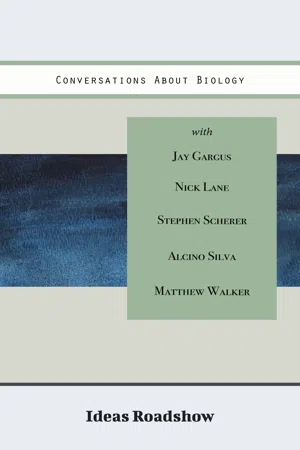
- English
- ePUB (mobile friendly)
- Available on iOS & Android
Conversations About Biology
About this book
FIVE BOOKS IN ONE! This collection includes the following 5 complete Ideas Roadshow books featuring leading researchers providing fully accessible insights into cutting-edge academic research while revealing the inspirations and personal journeys behind the research. A detailed preface highlights the connections between the different books and all five books are broken into chapters with a detailed introduction and questions for discussion at the end of each chapter: I. A Genetic Perspective - A conversation with Jay Gargus, Professor of Physiology, Biophysics and Pediatrics and Director of the Center for Autism Research and Translation at UC Irvine. This wide-ranging conversation examines the recent explosion in our genetic understanding and its implications for the future of medicine, together with the importance of understanding the underlying molecular mechanisms in order to successfully treat a wide range of genetic disorders. Prof. Gargus focuses on autism, dispelling myths associated with the condition, advocating why a treatment should be actively pursued, and illustrating what we can learn from the recent breakthrough in cystic fibrosis research.II. Learning and Memory - A conversation with Alcino Silva, Professor of Neurobiology, Psychiatry and Psychology at UCLA. Alcino Silva runs a learning and memory lab at UCLA that is focused on a vast number of topics, from schizophrenia and autism to learning and memory. This fascinating conversation explores how he and his colleagues focus on understanding the specific molecular mechanisms of neurobiology with the goal of being able to intervene and repair these mechanisms when they go awry. III. A Matter of Energy: Biology From First Principles - A conversation with Nick Lane, Professor of Evolutionary Biochemistry at University College London. After an inspiring story of Nick Lane's career path, this wide-ranging conversation covers his bioenergetic view of early, evolutionary history, the origin of life and how all complex life is composed of a very particular cell type that we all share, and more.IV. Our Human Variability - A conversation with Stephen Scherer, Research Chair in Genome Sciences at the Hospital for Sick Children and University of Toronto. Stephen Scherer discusses his lifelong passion for science that culminated in his groundbreaking discovery of copy number variation. This conversation also covers his exciting work in autism research and how copy number variation brings us a deeper understanding of both human variability and disease.V. Sleep Insights - A conversation with Matthew Walker, Professor of Neuroscience and Psychology at UC Berkeley. This extensive conversation gives a clear and compelling picture of our recent understanding of sleep's essential role in our daily lives, from reinforcing learning and memory to regulating emotion.Howard Burton holds a PhD in theoretical physics and an MA in philosophy. He was the Founding Director of Canada's Perimeter Institute for Theoretical Physics. For his award-winning initiative Ideas Roadshow, Howard has hosted and filmed in-depth conversations with more than 100 world-leading experts, including 3 Nobel Laureates. Ideas Roadshow conversations reveal the inspirations and personal journeys behind the research while providing behind-the-scenes insights into the world of frontline research.
Frequently asked questions
- Essential is ideal for learners and professionals who enjoy exploring a wide range of subjects. Access the Essential Library with 800,000+ trusted titles and best-sellers across business, personal growth, and the humanities. Includes unlimited reading time and Standard Read Aloud voice.
- Complete: Perfect for advanced learners and researchers needing full, unrestricted access. Unlock 1.4M+ books across hundreds of subjects, including academic and specialized titles. The Complete Plan also includes advanced features like Premium Read Aloud and Research Assistant.
Please note we cannot support devices running on iOS 13 and Android 7 or earlier. Learn more about using the app.
Information
Introduction
More Things in DNA, Horatio...
Table of contents
- Textual Note
- Preface
- Autism: A Genetic Perspective
- Learning and Memory
- A Matter of Energy
- Our Human Variability
- Sleep Insights